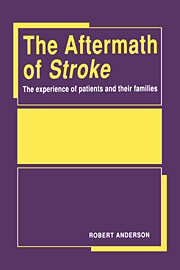Book contents
- Frontmatter
- Contents
- Acknowledgements
- Chapter 1 Stroke: An introduction to the problem
- Chapter 2 The Greenwich stroke study
- Chapter 3 Coming into medical care: the first month after stroke
- Chapter 4 Hospital care and rehabilitation
- Chapter 5 Survival, physical disability and health
- Chapter 6 Support in the community
- Chapter 7 The effects of stroke on social, family and personal life
- Chapter 8 Caring and coping with stroke
- Chapter 9 Resources for coping with stroke
- Appendix: Measurement and scoring of variables
- References
- Index
Chapter 6 - Support in the community
Published online by Cambridge University Press: 07 October 2011
- Frontmatter
- Contents
- Acknowledgements
- Chapter 1 Stroke: An introduction to the problem
- Chapter 2 The Greenwich stroke study
- Chapter 3 Coming into medical care: the first month after stroke
- Chapter 4 Hospital care and rehabilitation
- Chapter 5 Survival, physical disability and health
- Chapter 6 Support in the community
- Chapter 7 The effects of stroke on social, family and personal life
- Chapter 8 Caring and coping with stroke
- Chapter 9 Resources for coping with stroke
- Appendix: Measurement and scoring of variables
- References
- Index
Summary
Following the stroke, most patients in Greenwich were admitted to hospital and stayed there for several weeks; only 10% of the patients who survived to 9 months after the stroke were still in hospital then. The length of time for which patients were in hospital was clearly associated with the severity of their disability at 1 month after the stroke; this is shown in Table 37.
None of the patients who had lived at home with a spouse remained in hospital throughout the first 9 months (although some were subsequently re-admitted); this may be compared with 14% of patients in all other households, and 53% of those without a spouse who were severely or very severely disabled. Patients who lived alone were not generally more likely to stay in hospital longer than other patients, but patients aged 80 or over were more likely to be in hospital for the first 9 months – 23% compared with 4% of younger patients. This age difference fell below significance if only patients without spouses were considered (23% of patients aged 80 or over compared with 8% of those aged 60–79 were in hospital for all of the first 9 months after the stroke).
There were no differences in duration of stay in the hospital associated with the patient's sex or social class, or with the type of accommodation (private, council) that the patients had lived in before the stroke.
- Type
- Chapter
- Information
- The Aftermath of StrokeThe Experience of Patients and their Families, pp. 114 - 143Publisher: Cambridge University PressPrint publication year: 1992



